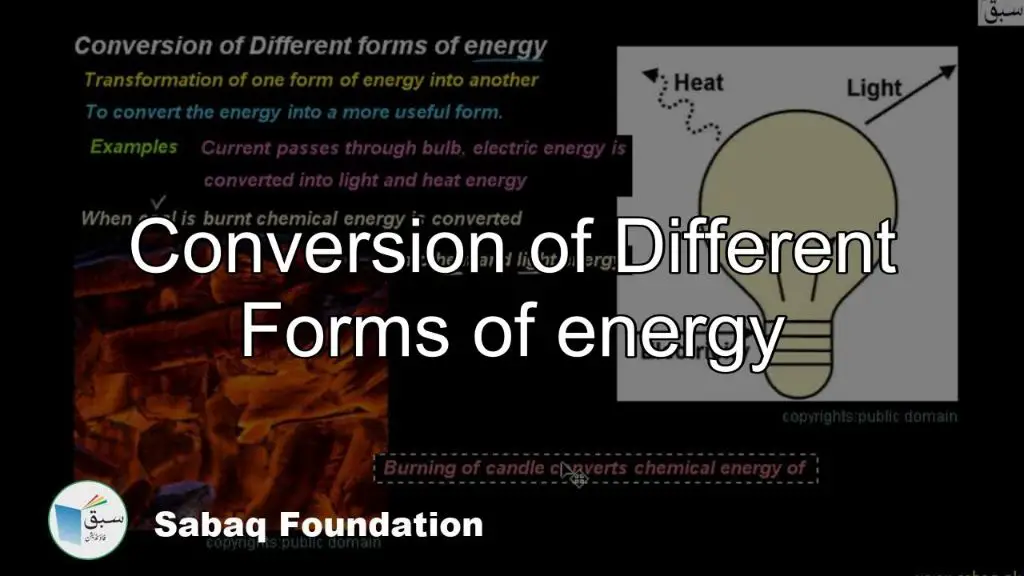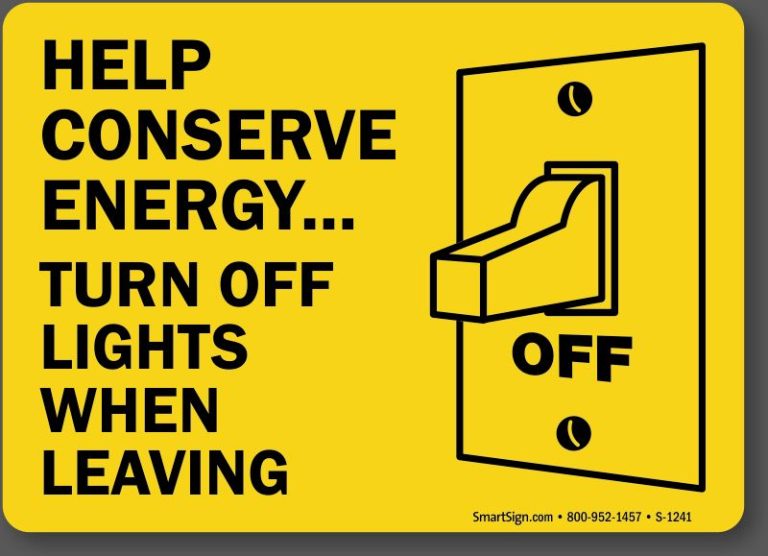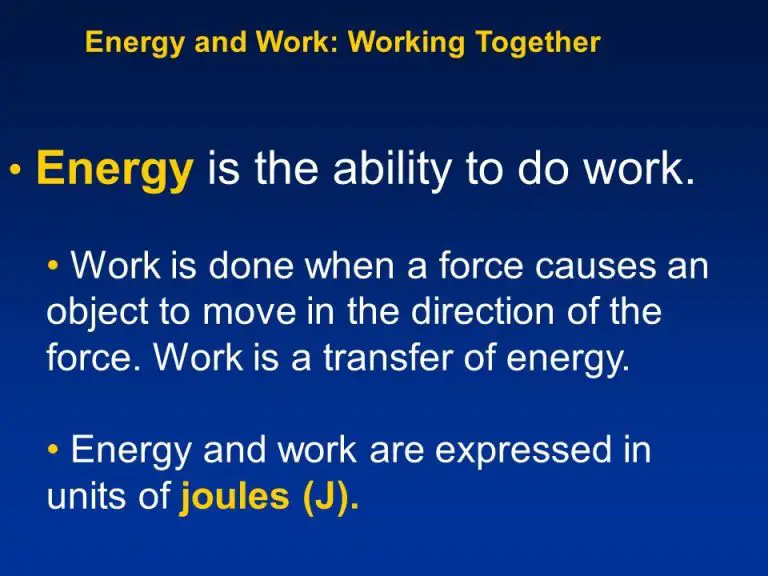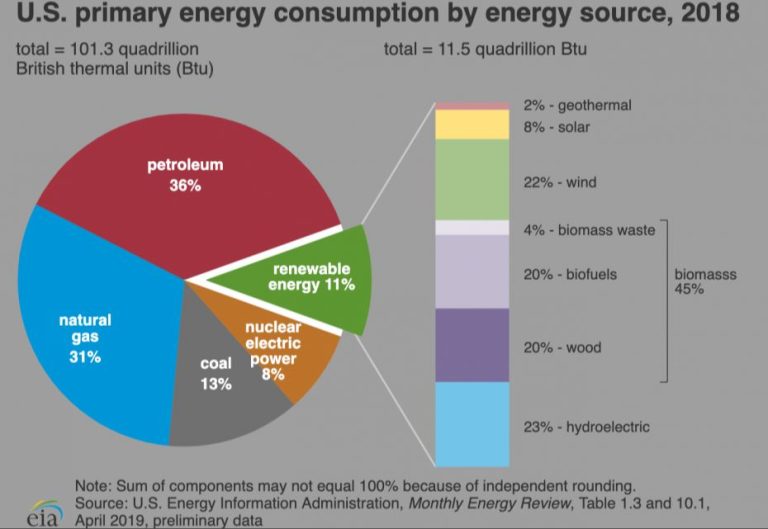Can Energy Be Converted Yes Or No?
Energy conversion is the process of changing energy from one form into another. According to the law of conservation of energy, energy can neither be created nor destroyed, it can only be converted from one form into another. For example, a combustion engine in a car converts the chemical energy stored in gasoline into mechanical energy that propels the car forward. The total energy before and after conversion remains the same.
There are many different forms that energy can take, including thermal, radiant, kinetic, potential, electrical, chemical, nuclear and more. The law of conservation of energy states that the total quantity of energy in an isolated system remains constant over time. In an energy conversion process, the amount of initial energy and final energy will be equal, as energy cannot be created or destroyed. While energy can change forms, the total amount of energy stays the same.
Forms of Energy
Energy comes in many different forms that can be categorized into two main types: potential energy and kinetic energy. Potential energy is stored energy that has the potential to do work, such as gravitational potential energy due to an object’s height or elastic potential energy stored in a compressed spring. Kinetic energy is energy of motion, such as the kinetic energy of an object moving or the kinetic energy of particle motion that makes up thermal energy. Other main forms of energy include:
- Chemical energy – Energy stored in the bonds of atoms and molecules. Chemical energy can be released during chemical reactions.
- Electrical energy – Energy from the movement of charged particles, such as in batteries.
- Magnetic energy – Energy from magnetic fields, which affects moving charged particles.
- Radiant energy – Energy carried by electromagnetic waves, such as light.
- Nuclear energy – Energy stored in the nucleus of an atom and released in nuclear reactions.
- Thermal energy – The internal kinetic energy of an object’s molecules that makes up its heat.
- Sound energy – Energy that travels by longitudinal waves through matter.
These different forms of energy can often convert between one another. For example, chemical energy in gasoline can convert into thermal energy and kinetic energy as it combusts in an engine. The categories also frequently overlap, such as thermal energy consisting of the kinetic energy of particles.
Energy Conversion Examples
One of the most common examples of energy conversion is the chemical energy stored in fuel being converted into thermal energy and light when burned. For instance, the chemical energy stored in natural gas, gasoline, or wood can be released through combustion to produce heat that warms homes and powers car engines. The chemical bonds holding the fuel molecules together contain potential energy that gets converted into kinetic energy as the molecules break apart. This kinetic energy manifests itself as heat and light energy during the reaction. Another example is the metabolic conversion of chemical energy from food into thermal, mechanical, and electrical energy in our bodies. The chemical energy stored in sugars, fats, and proteins gets broken down through digestion to release energy that allows our muscles to move and nerve cells to function.
In nuclear power plants, nuclear energy stored within uranium atoms gets converted into electrical energy. The process starts with a controlled nuclear fission reaction splitting uranium nuclei into smaller atoms, releasing kinetic energy in the form of heat. This thermal energy produces steam to spin a turbine generator which then converts the mechanical rotation into electrical energy. Photosynthesis by plants is also an important energy conversion process, turning light energy from the sun into chemical energy stored within glucose molecules.
Understanding how energy transforms between different states is essential for designing new technologies and effectively harnessing energy sources for human use. The study and application of energy conversion lies at the heart of fields like thermodynamics, chemical engineering, and power system engineering.
Mechanical Energy Conversion
Mechanical energy is the energy associated with the motion and position of an object. There are two main types of mechanical energy:
- Kinetic energy – the energy an object has due to its motion. The kinetic energy of an object depends on its mass and velocity.
- Potential energy – the stored energy an object has due to its position or shape. For example, a ball held at a height above the ground has gravitational potential energy that can be converted to kinetic energy as it falls.
Kinetic and potential energy can convert back and forth between each other in what are called conservative systems. Some common examples of kinetic and potential energy conversion include:
- A pendulum swinging back and forth converts between kinetic energy at the bottom of its swing to gravitational potential energy at the top of its swing.
- A rollercoaster going over hills converts between kinetic energy when moving fast at the bottom of hills to gravitational potential energy when stationary at the top of hills.
- A bouncing ball converts its kinetic energy to elastic potential energy stored in deformation of the ball as it collides with the ground, which is then converted back to kinetic energy as the ball recoils upwards.
The ability to convert between different forms of mechanical energy allows useful work to be extracted, such as a swinging pendulum able to lift an object or a rollercoaster able to complete a full circuit.
Electrical Energy Conversion
One of the most common and useful forms of energy conversion is between chemical and electrical energy in batteries. Batteries contain two electrodes separated by an electrolyte. The anode and cathode go through oxidation and reduction reactions, respectively, which generate electrons that can flow through an external circuit as electricity.
For example, in a standard alkaline battery the anode contains zinc while the cathode contains manganese dioxide. The electrolyte is potassium hydroxide. When the battery is connected to a device, the zinc oxidizes to zinc ions at the anode while manganese dioxide is reduced at the cathode. This reaction generates a flow of electrons from the anode to the cathode, providing electrical energy to power the device.
The amount of electrical energy available from a battery depends on its chemical composition and structure. Battery technology continues to advance, allowing more energy storage in smaller packages. But the fundamental principle of converting chemical energy to electrical energy via reduction-oxidation reactions underlies all batteries.
Nuclear Energy Conversion
Nuclear energy is converted into thermal energy through nuclear fission reactions inside nuclear reactors. In nuclear fission, atoms of nuclear fuel like uranium or plutonium split into smaller atoms, releasing a tremendous amount of energy in the form of heat. The process begins when a neutron strikes the nucleus of a fissile atom like uranium-235, splitting it into two lighter nuclei. This reaction also releases 2 or 3 more neutrons which go on to split other uranium nuclei, creating a chain reaction. The kinetic energy of the fission products heats up the fuel rods and reactor core, converting nuclear potential energy into thermal energy.
The thermal energy generated from nuclear fission is used to boil water into steam that spins a turbine to generate electricity. Nuclear power plants use the heat of nuclear fission to convert water into high-pressure steam at temperatures exceeding 300°C. This pressurized steam drives the blades of a turbine, which spins a generator to produce electricity. In this way, nuclear reactors efficiently convert nuclear energy into usable electrical energy through an intermediate conversion into thermal energy.
Overall, nuclear fission converts nuclear binding energy into thermal energy, which is further converted into mechanical energy and electrical energy. Nuclear power provides a stable and reliable baseload source of electricity without direct generation of air pollution or carbon emissions during operation, although the nuclear waste produced needs careful management. Nuclear energy currently provides about 10% of the world’s electricity.
Photosynthesis
Photosynthesis is the process by which plants use sunlight, carbon dioxide, and water to create their own food. This process converts light energy into chemical energy that the plant can use as fuel. During photosynthesis, plants absorb sunlight, usually through their leaves. The sunlight interacts with the chlorophyll in the plant cells, providing the energy needed to drive the chemical reaction.
Specifically, the light energy is used to split water molecules into hydrogen and oxygen. This releases electrons that are used to convert carbon dioxide into glucose, a simple sugar. The glucose provides energy that allows the plant to grow and fuel its activities. The oxygen is released into the atmosphere as a byproduct.
The overall chemical reaction looks like this:
6CO2 + 6H2O + light → C6H12O6 + 6O2
So in summary, photosynthesis converts the light energy from the sun into chemical energy that plants require for growth. This process is essential for life on Earth, since it provides the oxygen that animals need to breathe, and also forms the base of the food chain. Pretty much all life depends on photosynthesis and the ability to convert light into chemical energy.
Energy Conversion Efficiency
When energy is converted from one form to another, the conversion is never 100% efficient. Some energy is always lost in the process, usually in the form of heat. For example, a combustion engine converts the chemical energy in gasoline into mechanical energy to propel a car. However, a large amount of the energy in the gasoline is lost as heat in the engine, through friction and exhaust. The efficiency of a combustion engine is generally around 20-30%.
Even when converting between two forms of electromagnetic energy, such as electrical energy and light energy in an LED light bulb, there are always losses. LED light bulbs can achieve efficiencies around 20-30%. The theoretical maximum efficiency of converting electrical energy into light is about 83%, but that is never achieved in practice.
The efficiency of energy conversion processes is an active area of research and development. Improving efficiency has huge economic and environmental benefits, as less fuel and energy input is required to achieve the same useful output. However, there are thermodynamic limits to conversion efficiencies dictated by physics. 100% efficiency is likely unattainable in any real-world energy conversion process.
Practical Applications
The ability to convert energy from one form to another has enabled many important technologies that we rely on in everyday life. Some key practical applications that utilize energy conversion include:
Power Generation
Most of the electricity we use is generated at power plants by converting the chemical energy in fuels like coal, natural gas, or biomass into electrical energy through combustion and energy conversion systems like turbines and generators. The electrical energy is then distributed to homes and businesses through power lines.
Transportation
Gasoline and diesel vehicles convert the chemical energy in fuel into mechanical energy through internal combustion engines to propel the vehicle. Electric vehicles use batteries to convert stored chemical energy into electrical energy to run electric motors for propulsion.
Heating and Cooling Systems
Furnaces and boilers burn fuels to produce heat for buildings, converting chemical energy to thermal energy. Air conditioners and heat pumps move heat between the inside and outside of buildings by converting between thermal and mechanical energy.
Understanding how to efficiently convert energy allows us to harness natural sources of energy like fossil fuels, nuclear power, and renewables to meet the needs of modern civilization. Continued improvements in energy conversion technology and efficiency will be crucial to provide energy sustainably for the future.
Conclusion

In conclusion, the answer to the initial question of whether energy can be converted between different forms is a definitive yes. As explored throughout this article, there are numerous examples of energy conversions happening constantly around us. Mechanical energy like motion or gravitational potential can be converted into electrical energy through generators and turbines. Heat and radiation energy from nuclear reactions can likewise be converted into electricity. On a biological level, plants and other photosynthetic organisms are able to convert light energy from the sun into chemical energy stored within organic compounds. While no energy conversion process is 100% efficient due to losses as heat, there are many practical applications taking advantage of energy conversions, from hydroelectric dams to nuclear power plants to solar panels. By harnessing these conversions, we are able to transform one form of energy into the type we need to power our modern society and technologies. So in summary, energy absolutely can be converted between forms, which is a key principle underpinning much of our way of life today.







